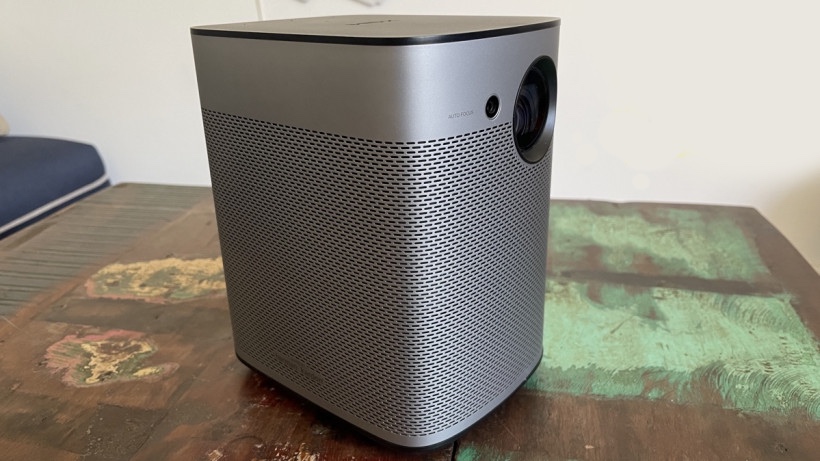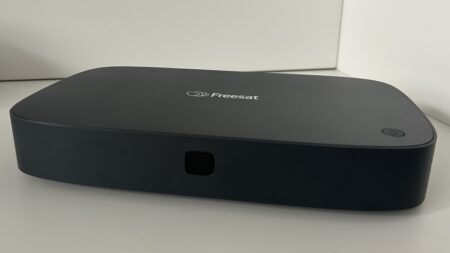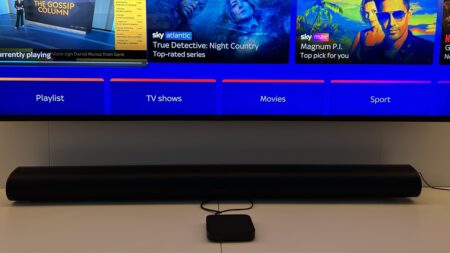Android TV powered home cinema system put to the test
The Xgimi Halo might be larger than much of the competition but it redefines what you can expect from a portable projector. With more brightness and higher resolution than the competition, you can use this model practically anywhere. That’s doubly true when you take the fancy auto setup and integrated battery into account. Android TV is nice to see, too, giving a smooth interface built for remote control use, but it’s a shame that Netflix doesn’t have integrated support, so you’ll likely need an alternative media streamer.
Pros
- Battery powered
- Bright
- Comparatively high resolution
- Excellent interface via Android TV
Cons
- Quite bulky for a portable model
- Netflix is not supported
- Not all Android apps work
While the idea of a portable projector that you can throw in a bag and use anywhere is a powerful one, the reality is that many models suffer from poor interfaces, are low resolution and aren’t that bright.
The Xgimi Halo largely redefines this perception, running Android TV, having a Full HD1080p resolution and a relatively bright output.
Top end rivals: The best 4K projectors
There are a few niggles along the way, including the lack of dedicated Netflix support, but if you’re looking for a battery-powered projector, this one is right up there with the very best.
Read on to find out why…
Xgimi Halo: Design
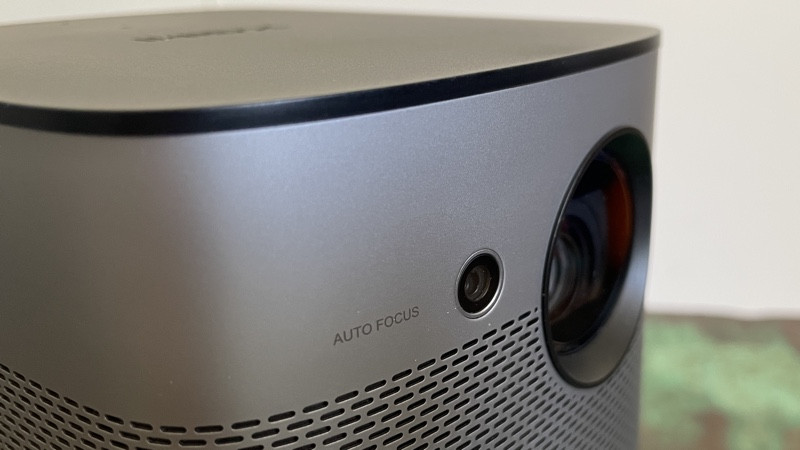
Portable projectors are all about balance, getting the combination of size and weight, against brightness and features.
At 172 x 114 x 114mm and weighing 1.6kg, the Xgimi Halo is just about as big and heavy as you can get away with for a portable model.
Compared to the competition, such as the Anker Nebula Capsule Max, this is quite a beast.
New model: Xgimi Horizon Ultra review
Part of that weight is down to the integrated battery, which means that you can technically use this projector anywhere. Xgimi also provides a large power bank (think of the type you’d expect to find bundled with a large laptop), which you can use to charge the battery and/or run the projector from the mains.
Still, you can fit it all into a bag (or suitcase) easily enough. It would be nice if Xgimi provided a case in the box, though; I recommend getting something to protect the projector, as the lens is fully exposed.
On the top of the projector, you get basic controls, with play/pause and volume control buttons. These are handy for quick operation, but if you want to do anything more complicated, you’ll need to turn to the provided Bluetooth remote control (batteries not included).

While there’s Android TV built-in, giving you apps directly, at the back of the projector, there’s also a standard HDMI input, plus a USB port, which you can use to stream media from directly.
Underneath there’s a foot, so you can angle the projector upwards, plus a standard tripod mount. I like the latter, as it makes this projector easy to set up anywhere, from a room to outside on a camping trip.
Xgimi Halo: Android TV and interface
Most portable projectors run a customised version of Android, which often leads to a fiddly interface that was built for touch use, rather than via remote control. Xgimi ups the game, running the regular Android TV platform.
It’s super easy to set up: Android phone users can simply transfer settings at the touch of a button; iOS users have to go through a more manual process, logging into their Google accounts.
In either case, it doesn’t take long to get the basic system set up.
Using Android TV has lots of benefits, including the same interface that you get on smart televisions running the same software. It’s easy to use, with lots of thumbnails and built for use with a remote control.
Xgimi’s remote is pretty good. It’s simple, with just the required buttons on there, so you’re not overwhelmed by hundreds of controls.

As it’s Bluetooth, you don’t need line of sight to the projector, and you can use the built-in microphone to control the Google Assistant for voice search or general queries.
You also get access to the full Google Play store, packed with apps. Yet, a word of caution: not everything you might expect is available, and there are some limitations.
For example, Netflix has to approve devices running Android TV, and the Halo hasn’t gone through the certification process. This means that while you can install Netflix, you can’t actually run it. (officially, at least). Fortunately, Disney+ and Amazon Prime Video work as expected.
Depending on where you live, there are some apps missing. too. In the UK, for example, I couldn’t find the Now TV app.
The lack of some apps (or those that won’t run) may mean that you need to use an external device to play media, such as a streaming stick. Luckily, the USB port on the projector is enough to power such a media streamer.
For apps available on the projector, there’s enough processing oomph here that they load fast and their interfaces are smooth.
I’d say that the Halo is a step up from its portable competition, which tends to be a little rough-and-ready and slower to respond.
I should point out that, unless you’ve got media on a USB stick, the Halo does need an internet connection to work, as you can’t download content for offline use.
The Nebula Capsule Max uses standard Android apps, so some, including Netflix, let you download content for offline viewing.
Xgimi Halo: Sound and picture quality
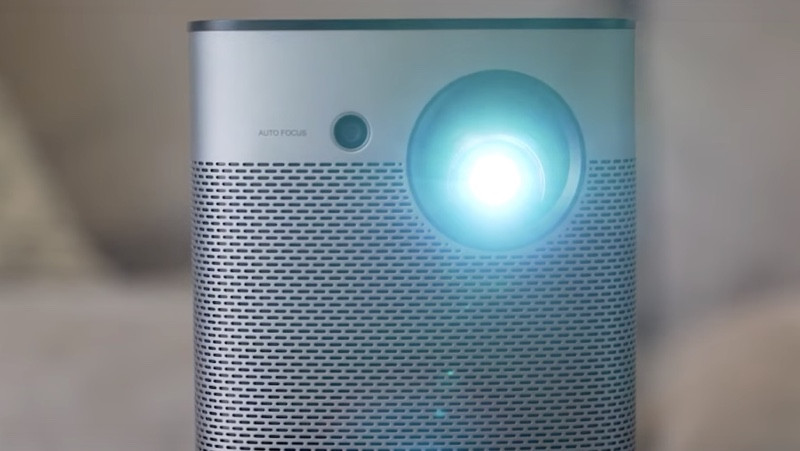
If there’s one thing that’s fiddly about projectors, it’s setting up the screen correctly. Here, Xgimi makes it easy.
When you turn the projector on or move it, the Halo runs through its autofocus routine. You have to adjust keystone manually but the four-point controls make it easy to get a square picture.
It’s still work lining up the projector as well as you can (keystone correction reduces image quality slightly), but the fact is that this is a no-hassle projector that you can plonk down, with autofocus doing most of the hard work.
Most portable projectors are quite dark, but the Xgimi Halo has a maximum brightness of 800 ANSI lumens (600 ANSI lumens on battery power).
The difference is hugely noticeable: while rivals need near-dark rooms to work, you can watch the Halo in a darkened room by pulling down shades. You can even use it on an overcast day without shutting curtains at all.
I found that I could get around a 50-inch picture during the day, going up to 100-inches when it got dark. Technically, this projector can go up to 300-inches, although you’d need it to be incredibly dark to do this, and have room for such a large screen.
If you want to use the projector outside, then it will work as it starts to get dark in the shade, with a smaller-TV-sized image, up to 100-inch or larger image when it’s properly dark.
With its Full HD resolution and higher brightness, image quality from the Xgimi Halo is far better than on any other portable model.
It’s sharp, bright and the colours are vibrant. If you watch something dark and moody, then you’ll want to watch at night or in a darkened room; if the room’s too bright, you tend to lose some detail.
Mostly, what you get here is fun: there’s nothing quite like watching a film on a truly large screen, and the Halo lets you do it practically anywhere.

This projector also has two 5W speakers, tuned by Harman Kardon. They lack the impact and bass of a full home cinema system, but they’re loud enough to fill a room and are loud enough to be heard clearly outside. That’s quite a difference over regular portable projectors, which are very quiet.
If you do want louder or more detailed sound, there’s a 3.5mm audio output or you can use Bluetooth to connect to an external speaker instead.
There’s no need to be next to a power socket, as you can even watch without power, with the internal battery lasting between two and four hours. On a camping trip, a portable hotspot was all I needed to watch a film without the need for any cables.
There’s an LED lamp in this projector, which is non-replaceable. As it has a rated life of 30,000 hours, it should last for around 10 years or more, assuming you use this projector for eight hours per day.


